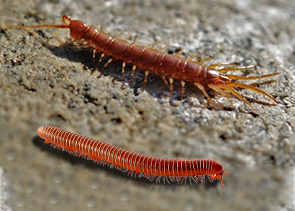Millipedes And Centipedes Control

It’s an interesting fact to note that there are around 80,000 types of Millipedes and 8,000 types of Centipedes. Approximately 70 types of Centipede are living in Canada. Wrenched Millipedes and Centipedes both have many body sections and numerous legs. Although, the Centipede has a more smoothed body and just one set of legs for every part, while the Millipede’s body is adjusted on top with two sets of legs for each segment. Additionally, the Centipede’s legs are any longer, permitting it to move all the more rapidly. When upset, millipedes will in general curl up, however centipedes quickly run for the nearest dim concealing spot.
Millipedes and Centipedes: Facts and Seasonal Habits
Many of you don’t know the fact but millipedes and centipedes are not insects. They belong to the same family of arthropod which is based on creatures with exoskeletons rather than boney skeletons inside their bodies. Scorpions, crickets, flies, and other familiar creatures are all members of the family. Millipedes and Centipedes eat rotting and dead plant debris. During the colder months of the year, they go inactive and enter a condition of dormancy. They wake up and start moving around again as the temperature warms up. This is why they might be found in and around the residence throughout the summer. Only a handful come out of hibernation at a time, but if a mated partner has been overwintering in or around your house, the female may have left up to 300 eggs at a time, all of which will grow when the weather warms up. This is what causes the infestations that might arise in particular locations from time to time.
Following rainstorms, millipedes and centipedes seek higher and dryer land, which is usually trees, plants, and buildings. Dame and decomposing debris, as well as certain smaller insects, especially dead ones, provide food for them. They can be found in huge numbers in the yard and garden area where there are lots of rotting plant materials to feed on since they seek wetness and humid surroundings. Indoors, they may be found around patio entryways, as well as in basements, kitchens, and restrooms. If they’re found inside, it’s most likely because they strayed in looking for food or refuge.
Reason Behind Centipedes and Millipedes infesting house?
Centipedes do not have the protective waxy skin on their nails and are, therefore, more susceptible to drying out. They look for a damp place like the basement or toilet. In general, they also seek shelter inside when winter temperatures drop. Millipedes also like wet and semi-dark places and seek shelter inside during winter.
Are Centipedes and Millipedes Dangerous?
Centipedes can also bite and you will feel the pain as if you are stung by the wasp. Millipedes are generally rolled into the tight spiral and will emit some toxic chemicals which can cause burns. Some of its common symptoms are blistering, skin irritation, tanning, burning or itching on skin.
Centipedes is having a body which is made from numerous segments, each with around one set of legs. These lengthy legs protrude from the sides of their bodies and trail behind them, making them quite noticeable. Centipedes can move incredibly swiftly because of their legs. They have lengthy antennae as well.
On either hand, millipedes are the polar opposite. The first three body segments of these arthropods contain just one pair of legs, but beyond that, each body segment has two pairs of legs. Their legs are shorter than centipedes’ and do not trail behind their bodies. Millipedes move significantly slower than their long-legged relatives due to their small legs. Millipedes can’t bite, either. They are scavengers who do not hunt for food.
So, which is the riskier of the two? When startled, millipedes wrap themselves into a ball shape, much like a pill bug. They exude a foul-smelling fluid that can irritate human skin and eyes if touched because they are unable to bite. Centipedes, on the other hand, will occasionally bite people if startled. A centipede bite resembles a bee sting in that it leaves a red mark that might enlarge, itch, or sting. Millipedes and centipedes are not considered hazardous to humans or pets, despite their protective tactics. These pests are not known to spread illnesses or contaminate food, furniture, or plants.
Our Approach Towards Removal of Centipedes And Millipedes
If Millipedes and Centipedes are in your house and causing problems, contact the ASM Pest Control Team to learn more about our Pest Control Services as part of our Home Pest Control Service and protect the basement from unwanted pests this summer.
Your Local Pest Control Experts In Surrey and Nearby Areas
We proudly provide professional pest control services in Surrey and surrounding areas. Our team ensures that homes and businesses remain safe and pest‑free with effective and environmentally responsible solutions. Whether you are facing ants, rats, mice, wasps, or other common pests, we offer reliable removal and prevention strategies to protect your property.
Call us at ASM Pest Control, where our experts will help locate and accurately identify the presence of pests. This way, they can provide you with a range of control alternatives for any new infestation issue.
Need help with pest infestations? ASM Pest Control is ready to help!
Same Day Pest Removal For
Residential, Commercial &
Industrial
Residential, Commercial &
Industrial
If you are looking for a licensed pest exterminator in the Lower Mainland, your search ends here. With years of experience in integrated pest management, we are proudly serving the residential, commercial, and industrial clients with effective and long-lasting services. We not only eliminate unwanted insects but also follow measures to restrict and prevent their entry in the future. Our approach includes:
- Inspection
- Control
- Prevention
- Trapping
- Extermination
- Follow-up

Same Day Pest Control Services
We are proud to serve residential, commercial, and industrial clients with services that are effective and long-lasting thanks to our years of experience in integrated pest management.















